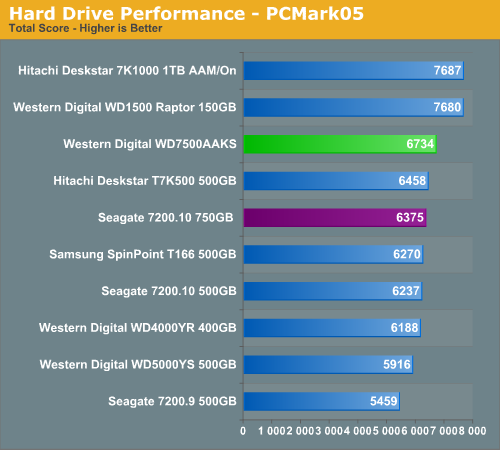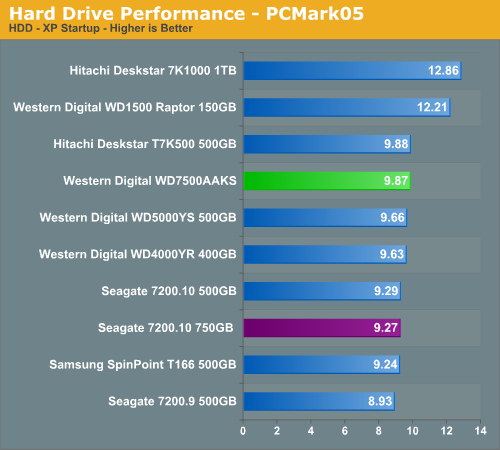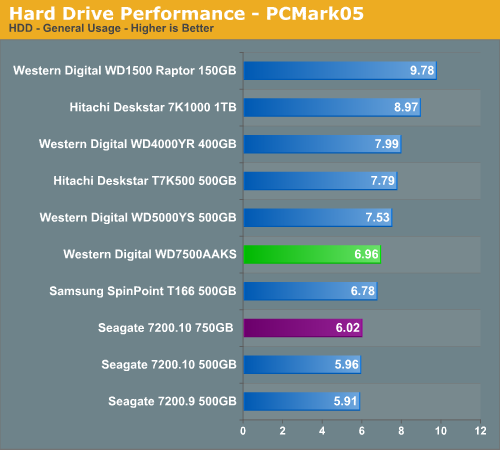Western Digital SE16 750GB: "Quiet" a Performer
by Dave Robinet on August 9, 2007 2:00 AM EST- Posted in
- Storage
PCMark05
We are utilizing the HDD test suite within PCMark05 for further comparative hard disk scores as it provides a mixture of actual application results and specific read/write percentages utilized within these programs. The program utilizes the RankDisk application within the Intel iPEAK SPT suite of tools to record a trace of disk activity during usage of real world applications. These traces are then replayed to generate performance measurements based upon the actual disk operations within each application. The HDD test suite contains 53% read and 47% write operations with each trace section utilizing varied amounts of read or write operations. Additional information about the test suite can be found in PDF format in the PCMark05 whitepaper.
Our test results are based upon the following trace runs:
Windows XP Startup: This test consists of 90% reading and 10% writes that tracks XP activities at start-up.
Application Loading: This test consists of 83% reading and 17% writes that tracks the opening and closing of the following programs.



The WD7500AAKS's score of 6704 puts it squarely in third place once again, being bested only by the WD Raptor and the Hitachi 7K1000. Of note, the drive is nearly 8% quicker in the PCMark05 test than its 750GB competition from Seagate.
We are utilizing the HDD test suite within PCMark05 for further comparative hard disk scores as it provides a mixture of actual application results and specific read/write percentages utilized within these programs. The program utilizes the RankDisk application within the Intel iPEAK SPT suite of tools to record a trace of disk activity during usage of real world applications. These traces are then replayed to generate performance measurements based upon the actual disk operations within each application. The HDD test suite contains 53% read and 47% write operations with each trace section utilizing varied amounts of read or write operations. Additional information about the test suite can be found in PDF format in the PCMark05 whitepaper.
Our test results are based upon the following trace runs:
Windows XP Startup: This test consists of 90% reading and 10% writes that tracks XP activities at start-up.
Application Loading: This test consists of 83% reading and 17% writes that tracks the opening and closing of the following programs.
- Microsoft Word
- Adobe Acrobat Reader
- Windows Media Player
- 3Dmark 2001SE
- Leadtek WinFast DVD
- Mozilla Internet Browser
- Opening a Microsoft Word document, performing grammar check, saving and closing.
- Compression and decompression using WinZip
- Encrypting and decrypting a file using PowerCrypt
- Scanning files for viruses using F-Secure Antivirus
- Playing an MP3 file with Winamp
- Playing a WAV file with Winamp
- Playing a DivX video using DivX codec and Windows Media Player
- Playing a WMV video file using Windows Media Player
- Viewing pictures using Windows Picture Viewer
- Browsing the Internet using Microsoft Internet Explorer
- Loading, playing and exiting a game with Tom Clancy's Ghost Recon




The WD7500AAKS's score of 6704 puts it squarely in third place once again, being bested only by the WD Raptor and the Hitachi 7K1000. Of note, the drive is nearly 8% quicker in the PCMark05 test than its 750GB competition from Seagate.










37 Comments
View All Comments
Dave Robinet - Thursday, August 9, 2007 - link
Actually, the difference is that the EIDE drive only is offered up to a 500GB capacity. This precludes it from having the additional features given to the 750GB drive, as mentioned in the article.If you're only using the single drive under "normal" desktop usage, however, you're not terribly likely to see a big difference in performance between a 500GB SATA and 500GB EIDE, all things being equal.
Thanks for reading!
dave
semo - Thursday, August 9, 2007 - link
i understand the sata vs. pata arguments. it's just the new features and low power draw that interest me and since the model numbers look so similar i thought that they would share the same characteristics.Frumious1 - Thursday, August 9, 2007 - link
Besides the one using a slower, outdated interface? Probably not. Thankfully, the 750GB drive is NOT available in PATA format as far as I can tell. WD's EIDE offerings top out at 500GB on their website. Seriously, who buys a top-end hard drive in EIDE format these days? Hell I only have one IDE connection on my motherboard, and that's no longer in use!semo - Thursday, August 9, 2007 - link
the 750gb version may be a top end part but the 500gb is very reasonably priced. anyway, you can never convince me that a hard drive is "high end", whatever the cost. real world performance does not vary much and depends very much on usage patterns. now an ssd or a revolutionary redesign of hdd i can consider to be high end.Dave Robinet - Thursday, August 9, 2007 - link
Agreed - if you can use SATA, you will. Some people can't, however, and the EIDE interface isn't an incredible bottleneck to the system (like, for example, the move from ISA to PCI graphics cards was in adopting the new bus).You're right, though - there's no reason to intentionally buy EIDE anymore if you have SATA available in your system. :)
Thanks for reading!
dave
Basilisk - Thursday, August 9, 2007 - link
'Won't there be negligible P-ATA demand, with none from manuf's? So, 'probably no P-ATA version, or a hefty premium on it.If my Linux distro supported the S-ATA controller chip, I'd spend the $20-$25 on a PCI or PCI-e S-ATA card and ignore the P-ATA. It would be a shame to have that P-ATA 750GB and later find yourself w/o a m/b having P_ATA to make good use of it! [Okay, you could probably buy a P-ATA controller card....]
wilburpan - Thursday, August 9, 2007 - link
Who buys a large capacity EIDE hard drive? I did recently.Why? I have an old computer that I've repurposed into a file server running Linux. This computer is old enough that it doesn't have SATA connections.